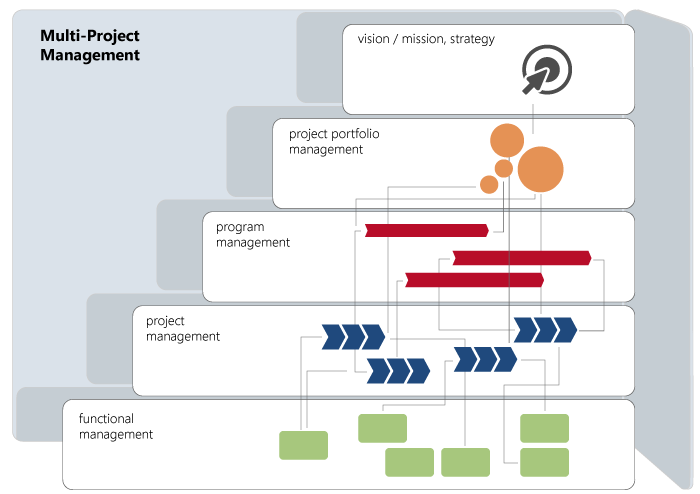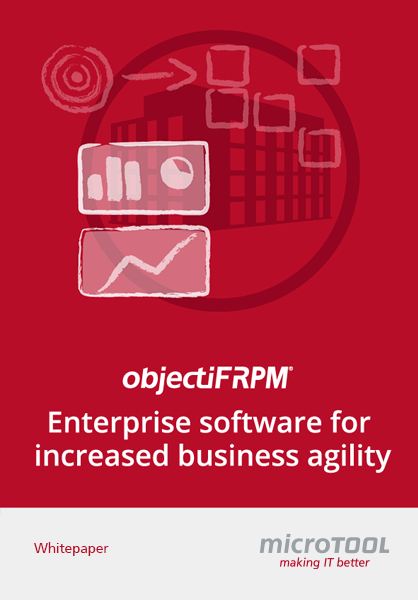Project Portfolio Management. Managing the Right Projects to Add Value to the Organization.
What is project porfolio management? When do you need it and how does it differ from multi-project management and program management?

Multi-project management can be used for various types of parallel running projects. The term applies to both programs and portfolios.
Ideally, all projects, programs and portfolios contribute to the achievement of the vision / mission.
The standard for portfolio management:
While project and program management are about executing projects correctly, portfolio management is about executing the right projects.
Definitions
The term project portfolio management is increasingly replacing the term (strategic) multi-project management, which is predominantly used in German-speaking countries. This is certainly also due to the fact that in English the term was popularized by the Project Management Institute (PMI®) with the publication of the “Standard for Portfolio Management” in 2008.
In 2011, the UK Office of Government Commerce (OGC) published another guideline entitled: “Management of Portfolios”, in short MoP®.
Since 2013, the German standards DIN 69909-1 and DIN 69909-2 “Multi-Project Management – Management of Project Portfolios, Programs and Projects” have described fundamentals, processes and process models for the three P levels.
In 2015, the standard was supplemented by Parts 3 “Methods” and 4 “Roles”.
Evaluate, prioritize, approve or reject Project Proposals
Analyze Dependencies
Group Projects
Controlling current Projects
Coordinate ongoing Projects
Evaluate completed Projects
secure empirical values and make them available for follow-up projects
Define and innitiate new Projects
Project management is like a flight that takes passengers to a specific destination. Program management is like air traffic control, which ensures that air traffic runs smoothly. Portfolio management is like operating an airport to keep it profitable and safe.
What Are the Differences between
Multi-Project Management?
Multi-project management refers to the planning, comprehensive control and monitoring of several projects that do not necessarily belong together. Conflicts between individual projects (e.g. about resources or goals) should be balanced. In this respect, multi-project management connects the management level with the project level. In comparison to portfolio management, the focus is not necessarily on the implementation of the overall strategy of an organization, but rather on the coordination and control of the jointly managed projects. Multi-project management is often used as a generic term for program and portfolio management.
Program Management?
Program management is the initiation, planning, monitoring and controlling of several content-related projects that serve a common, overall goal. A program is limited in time. Project portfolio management is usually not limited in time. It serves to continuously economically optimize conflicts and dependencies between projects. Program management is formally located one level below the portfolio.
Agile Portfolio Management
As more and more projects are carried out in an agile approach, agile principles must also be applicable across projects and overarching. Agile portfolio management means proceeding with iterations and increments even at the portfolio level. While classic project management designates budgets annually and specifies the framework and goals for project implementation at the operational level, in agile portfolio management decisions are made at levels that ensure the operational implementation of the strategy. To achieve this, this level must participate in the definition of strategic corporate goals, always have them present and want to implement them independently.
Agile Portfolio Management:
- can be performed on three levels. The operational level (with sprints of 1-4 weeks), the tactical level (with iterations of 2-3 months) and the strategic level (with target definitions of 1-2 years). Management according to the Objectives and Key Results Principle (OKR), for example, also calls for such a phasing
- means that all levels proceed iteratively according to the PDCA/Deming (Plan – Do – Check – Act) cycle. Minimum Viable Products (MVP) are used for market evaluation
- requires continuous coordination of all goals at all levels
- requires measurement of throughput across the entire company, e.g. using a company Kanban board with different flight levels
- uses variables such as NPV Net Present Value (value that can be achieved by completing an item, considering delay costs and interest rate effects), CoD Cost of Delay (delay costs that would be incurred) or WSJF Weighted Shortest Job First (relative estimation of which item will quickly generate value and feedback) to prioritize backlogs
- assumes that work comes to the teams and not vice versa
Lean Portfolio Management
Lean Portfolio Management (LPM) is a triad of terms used in Dean Leffingwell’s Scaled Agile Framework®, SAFe®. It is a new type of portfolio management characterized by a strategy for and financing of so-called value streams, agile, iterative working methods and lean management with a focus on continuous improvement.
How Lean Portfolio Management differs from classical project portfolio management:
- work is assigned to staff, not the other way around
- the desired results are defined, not the desired amount of results
- “value” is clearly defined and constantly redefined and value creation is more important than cost controlling
- decisions and plans are discussed retrospectively and at fixed intervals on the basis of new feedback
- budget and financing is flexibly adjusted in short cycles, instead of being fixed annually
- decisions are made decentrally in self-organized teams
While traditional project portfolio management involves allocating resources to implement concrete plans that are expected to produce specific results, lean portfolio management focuses on assigning resources to a fixed team (the so-called team of teams) so that it can use its resources to implement initiatives. The resulting solutions are continuously evaluated for their value creation.

